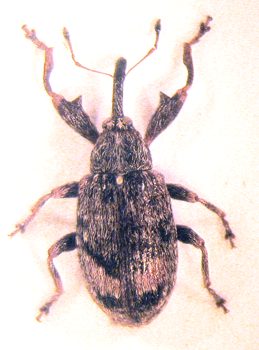Pests
Anthonomus pomorum L. - Apple Blossom Weevil.
Systematic position.
Class Insecta, order Coleoptera, family Curculionidae, genus Anthonomus. Closely related to A. humeralis Panzer and A. curtulus Desbr. Differs from A. humeralis Panzer in larger body size and more elongated first two segments of the funicle, from A. curtulus Desbr. in oblique transverse band behind the middle of elytra.Biological group.
A pest of apple and (not often) pear and cherry.Morphology and biology.
Body length, 3.4-4.3 mm. Rostrum parallel-sided, with distinct median carina. Flagellum with 7 segments. Elytra with oblique band behind the middle. Fore femur with the largest tooth. In spring the beetles are actively running and flying when the average air temperature is 10°C; adult feeding on buds is necessary for maturation. Fertility is not more than 100 eggs, which are oval and milky-white. Female lays eggs one by one into buds between pistil and stamens, as soon as the buds are thrown off the scales. Ovi-position continues before balloon.s status. One week later larvae hatch and eat generative organs inside the flower buds, extracting sticky excretions, and blossoming becomes impossible. Larvae develop in about 2 weeks. The bud turns brown, gets dry and falls to the ground. The pupal development lasts more than 1 week, then the young beetles emerge from the buds through a round hole. The young beetles eat parenchyma from upper side of leaves, and their harmfulness is insignificant. Adults enter winter diapause at the end of summer and find refuge under the bark of trees.Distribution.
Inhabits USA and most of Palaeoarctic territory except for the northern part of Scandinavia. In the former USSR it is widely distributed in the European part to the Ural Mountains in the East, in the Caucasus and in the Far East. Records of this species from Middle Asia and Siberia are probably misidentifications.Ecology.
Everywhere monovoltine. Emergence after winter diapause coincides with buds blossoming. Beetles like shadow and prefer dense plantation and northern side of the tree crowns. Most beetles concentrate along border of gardens near forest shelter-belts. Trees with abundant blossoming are most attractive for the beetles. Pimpla pomorum L., P. examinator F., P. sajor Stg., Bracon variator Gour., Campoplex latus Rtz., Chrysolampus aeneus Rtz., Apanteles spurius (Wesm.) are parasites of the Apple Blossom Weevil. Sometimes nearly 90% of larvae are eliminated by the latter predator.Economic significance.
Most dangerous in long springs with long blossoming. Damage of 50% of buds while strong blossoming and to 25-30% while weak or moderate blossoming which does not affect yield. Harmfulness is more noticeable when the abundance of the pests per one tree is about 200-300 specimens, and they injure about 70% of buds. Harming ability depends on the varieties of the trees. Burning-up plant garbage in the gardens, catching bands, and whitening apple trunks are important preventive control measures against the Apple Blossom Weevil.Reference citations:
Dieckmann L. 1968. Revision of West-Palaearctic Anthonomini (Coleoptera, Curculionidae). Beitr. Ent., Berlin, 17(3/4): 377-564. (In German)Dobrovol'skii B.V. 1959. Distribution of insect pests. Moscow: Sovetskaya Nauka. 215 pp. (In Russian)
Zemlina A.G. 1962. Apple Blossom Weevil Anthonomus pomorum L. in the Primorskii Territory. Reports of DVO AN SSR, Vladivostok, N.15: 77-82. (In Russian)


